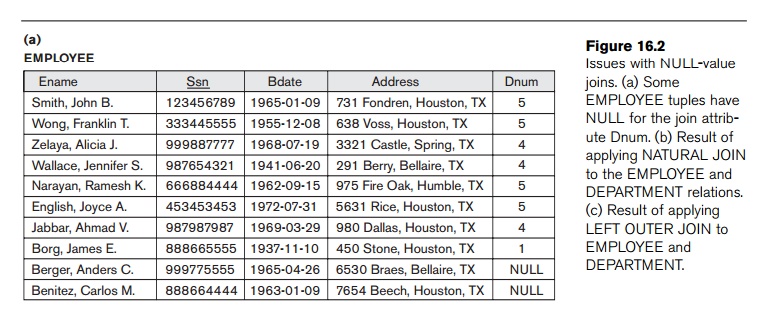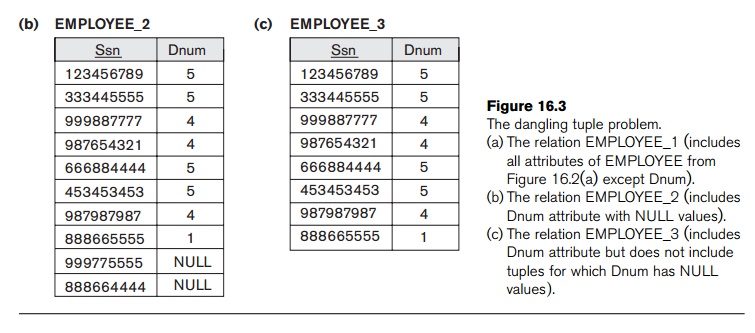Chapter: Fundamentals of Database Systems : Database Design Theory and Normalization : Relational Database Design Algorithms and Further Dependencies
About Nulls, Dangling Tuples, and Alternative Relational Designs
About Nulls, Dangling Tuples, and Alternative Relational Designs
In this section we will discuss a few general issues related to problems
that arise when relational design is not approached properly.
1. Problems with NULL
Values and Dangling Tuples
We must
carefully consider the problems associated with NULLs when designing a relational database schema. There is no fully
satisfactory relational design theory as yet that includes NULL values. One problem occurs when
some tuples have NULL values
for attributes that will be used to join individual relations in the
decomposition. To illustrate this, consider the database shown in Figure
16.2(a), where two relations EMPLOYEE and DEPARTMENT are shown. The last two employee
tuples— ‘Berger’ and ‘Benitez’—represent newly hired employees who have not yet
been assigned to a department (assume that this does not violate any integrity
constraints). Now suppose that we want to retrieve a list of (Ename, Dname) values for all the employees. If we apply the NATURAL JOIN operation on EMPLOYEE and DEPARTMENT (Figure 16.2(b)), the two
aforementioned tuples will not
appear in the result. The OUTER JOIN operation, discussed in Chapter
6, can deal with this problem. Recall that if we take the LEFT OUTER JOIN of EMPLOYEE with DEPARTMENT, tuples in EMPLOYEE that have NULL for the join attribute will still appear in the result, joined with
an imaginary tuple in DEPARTMENT that has NULLs for all its attribute values.
Figure 16.2(c) shows the result.
In
general, whenever a relational database schema is designed in which two or more
relations are interrelated via foreign keys, particular care must be devoted to
watch-ing for potential NULL values
in foreign keys. This can cause unexpected loss of information in queries that
involve joins on that foreign key. Moreover, if NULLs occur in other attributes, such as Salary, their
effect on built-in functions such as SUM
and AVERAGE must be carefully evaluated.
A related
problem is that of dangling tuples,
which may occur if we carry a decomposition too far. Suppose that we decompose
the EMPLOYEE relation in Figure 16.2(a)
further into EMPLOYEE_1 and EMPLOYEE_2, shown in Figure 16.3(a) and
16.3(b). If we apply the NATURAL
JOIN
operation to EMPLOYEE_1 and EMPLOYEE_2, we get the original EMPLOYEE relation. However, we may use the alternative representation, shown
in Figure 16.3(c), where we do not
include a tuple





in EMPLOYEE_3 if the employee has not been
assigned a department (instead of including a tuple with NULL for Dnum as in EMPLOYEE_2). If we use EMPLOYEE_3 instead of EMPLOYEE_2 and apply a NATURAL JOIN on EMPLOYEE_1 and
EMPLOYEE_3, the tuples for Berger and
Benitez will not appear in the result; these
are
called dangling tuples in EMPLOYEE_1 because they are represented in
only one of the two relations that represent employees, and hence are lost if
we apply an (INNER) JOIN operation.
2. Discussion of
Normalization Algorithms and Alternative Relational Designs
One of
the problems with the normalization algorithms we described is that the
database designer must first specify all
the relevant functional dependencies among the database attributes. This is not
a simple task for a large database with hundreds of attributes. Failure to
specify one or two important dependencies may result in an undesirable design.
Another problem is that these algorithms are not deterministic in general. For example, the synthesis algorithms (Algorithms 16.4 and 16.6) require the
specification of a minimal cover G
for the set of functional dependencies F.
Because there may be in general many minimal covers corresponding to F, as we illustrated in Example 2 of
Algorithm 16.6 above, the algorithm can give different designs depending on the
particular minimal cover used. Some of these designs may not be desirable. The
decomposition algorithm to achieve BCNF (Algorithm 16.5) depends on the order
in which the functional dependencies are supplied to the algo-rithm to check
for BCNF violation. Again, it is possible that many different designs may arise
corresponding to the same set of functional dependencies, depending on the
order in which such dependencies are considered for violation of BCNF. Some of
the designs may be preferred, whereas others may be undesirable.
It is not
always possible to find a decomposition into relation schemas that pre-serves
dependencies and allows each relation schema in the decomposition to be in BCNF
(instead of 3NF as in Algorithm 16.6). We can check the 3NF relation schemas in
the decomposition individually to see whether each satisfies BCNF. If some
relation schema Ri is not
in BCNF, we can choose to decompose it further or to leave it as it is in 3NF
(with some possible update anomalies).
To
illustrate the above points, let us revisit the LOTS1A relation in Figure 15.13(a). It is a relation in 3NF, which is not in
BCNF as was shown in Section 15.5. We also showed that starting with the
functional dependencies (FD1, FD2, and FD5 in Figure 15.13(a)), using the
bottom-up approach to design and applying Algorithm 16.6, it is possible to
either come up with the LOTS1A relation
as the 3NF design (which was called design X
previously), or an alternate design Y
which consists of three relations S1,
S2, S3 (design Y),
each of which is a 3NF relation. Note that if we test design Y further for
BCNF, each of S1, S2, and S3 turn out to be individually in BCNF. The design X, however, when tested for BCNF, fails
the test. It yields the two relations S1
and S3 by applying
Algorithm 16.5 (because of the violating functional dependency A → C). Thus, the bottom-up design
procedure of applying Algorithm 16.6 to design 3NF relations to achieve both
properties and then applying Algorithm 16.5 to achieve BCNF with the
nonadditive join property (and sacrificing functional dependency preservation)
yields S1, S2, S3 as the final BCNF design by one route (Y design route) and S1, S3
by the other route (X design route).
This happens due to the multiple minimal covers for the original set of
functional dependencies. Note that S2
is a redundant relation in the Y
design; however, it does not violate the nonadditive join constraint. It is
easy to see that S2 is a
valid and meaningful relation that has the two candidate keys (L, C), and P placed side-by-side.
Table
16.1 summarizes the properties of the algorithms discussed in this chapter so
far.


Related Topics